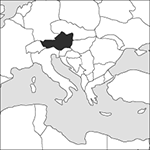
Capital:
Vienna
Area:
83,857 sq km (32,377 sq miles)
Population:
8,219,743 (2012 est)
Currency:
1 euro = 100 cents
Religions:
Roman Catholic 73.6%; Protestant 4.7%; Muslim 4.2%
Ethnic Groups:
Austrian 91.1%; Croat, Slovene, Serb, and Bosniak 4.0%; Turkish 1.6%
Languages:
German (official) and other minority languages
International Organizations:
UN; OECD; EU; Council of Europe; OSCE; Euro‐Atlantic Partnership Council; WTO
A country in central Europe, bounded by Italy, Slovenia, and Croatia to the south, Hungary and Slovakia to the east, the Czech Republic and Germany to the north, and Liechtenstein and Switzerland to the west.
Physical
Much of Austria is mountainous, with the River Danube flowing through the north‐east of the country. Austria is the most densely forested nation in central Europe, with 40% of its land covered by trees. In the Alpine regions, south‐facing mountain slopes have been cleared for pasture land and crops. In the Danube valley, arable land is characterized by very fertile soils.
Economy
The economy has large service and industrial sectors, with agriculture contributing only 1.6% of GDP. Industries include construction, manufacturing, food processing, timber, wood processing, paper, cardboard, metals, chemicals, and communications equipment. Tourism is also important. Trade is largely with western Europe, especially Germany. A large portion of the Austrian economy was placed in public hands after World War II, but most of this has now been privatized.
History
The Celtic tribes which had settled in the area from about 500 to 200 bc were conquered by the Romans in 14 bc, and the region remained part of the Roman empire, with the Danube as its frontier. A succession of Germanic invaders (Vandals, Goths, Huns, Lombards, and Avars) in the 5th century ad ended with a short period of stability under Charlemagne. Magyar invaders then followed, but these were decisively defeated by Otto I (the Great) at the Battle of Lechfeld in 955. Otto invested Leopold of Babenberg with the title of Margrave of Austria, and the Babenberg dynasty lasted until 1246. In 1282 Rudolf I, Count of Habsburg invested his two sons jointly as Dukes of Austria, the older son Albert (Duke of Austria 1282–1308) founding a dynasty which survived into the 20th century. The first Habsburg Holy Roman Emperor was Frederick III (1452–93) and perhaps the greatest Charles V (1530–56). From Vienna, the Habsburgs ruled the vast empire which, before its dissolution in 1918, included Hungary, Bohemia, Moravia, Burgundy, Tuscany, Piedmont, Croatia, Bosnia and Herzegovina, Bukovina, Slovenia, parts of Serbia, of Romania, and of Spanish America, Silesia, Spain, Luxembourg, The Netherlands, Venetia, and Naples. In 1575 the court moved from Vienna to Prague, where it remained until 1621. Vienna withstood a Muslim siege in 1529 and again in 1683, when the Polish army forced the Ottoman retreat. The War of the Austrian Succession brought the conflict over supremacy in the German orbit to a head, and the Seven Years’ War confirmed Prussia as a power of equal weight. The end of the 18th century saw almost continuous conflict, with Austrians fighting against the French revolutionary armies in The Netherlands, the Rhineland, and northern Italy. The unification of Germany by Prussia in 1866–71 excluded the Austrian empire from German affairs and destroyed hopes for the creation of a union of all the German‐speaking peoples. Austria was forced to make concessions to the Hungarians by forming Austria‐Hungary. Austrian diplomats, however, retained links with the new German Second empire, and tried to gain German support for their ambitions against Russia in the Balkans through an alliance system. During World War I the Austrian Imperial Army was virtually under German military control. Defeat and revolution destroyed the monarchy in 1918, and the first Austrian republic which followed it was only a rump of the former state. This was destabilized by the Nazis, who in 1934 murdered Dollfuss and staged an abortive coup. They were more successful in achieving Anschluss in 1938, when Hitler’s army invaded the country without opposition. Defeated in World War II, Austria was invaded by Soviet troops, and divided into separate occupation zones, each controlled by an Allied Power. In 1955 a treaty between the Allies and Austria restored full sovereignty to the country. The treaty prohibited the possession of major offensive weapons and required Austria to pay heavy reparations to the USSR, as well as to give assurances that it would ally itself with neither East nor West Germany, nor restore the Habsburgs. It remained neutral, democratic, and increasingly prosperous under a series of socialist regimes. The socialists were re‐elected in general elections in 1995, the year in which Austria joined the European Union. In 2000, the participation of the extreme right‐wing Freedom Party in a new governing coalition led to temporary diplomatic sanctions by the EU and some other countries. Austria adopted the euro as its currency in 1999–2002. Support for the Freedom Party collapsed at the 2002 elections, and they have been out of government since then. However, their popularity is increasing (fuelled by the pressures of the migrant crisis from 2014 onwards). The party only just lost the 2015 presidential elections, which they disputed, forcing a rerun, in December 2016.
- addition polymerization
- addition reaction
- addition rule
- additive
- additive function
- additive group
- additive identity
- additive inverse
- additive model
- additive primary colours
- additive process
- additive synthesis
- Addled Parliament (5 April–7 June 1614)
- add-on
- add-on manager
- add-on virus
- address
- addressability((of a display device))
- addressable location
- address book
- address bus
- address calculation sorting
- address format
- address harvester
- addressing